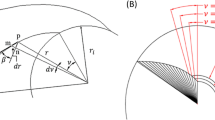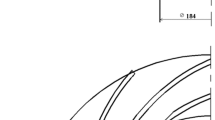Abstract
A centrifugal blood pump is a common type of pump used as a left ventricular assist device in the medical industries. Therefore, the improvement of the device bio-compatibility to reduce the blood damage and to increase the efficiency has become a major challenge. In the current work, a metamodel-assisted genetic algorithm is employed to simultaneously optimize the impeller and volute geometries of a typical centrifugal blood pump. The overall shape of the base design is inspired from HeartMate3 LVAD, and the main dimensions of the base design including inlet and outlet radius, blade angle distribution, volute cross-section area distribution, etc., are designed in our laboratory. Three different scenarios are investigated using three different objective functions, i.e., (1) hydraulic efficiency, (2) pressure head, and (3) hemolysis index (HI). The results showed that the shape optimized by pump efficiency has also nearly the same level of HI as the shape optimized by HI. Hence, to reduce computation time, one can use efficiency instead of HI as an objective function. However, one must check the HI level after such optimization to see whether it is within the acceptable range of HI for such bio application.



Similar content being viewed by others
References
Mozaffarian D, Benjamin EJ, Go AS, Arnett DK, Blaha MJ, Cushman M, et al. Heart disease stroke statistics—2015 update. Circulation. 2015;131:e29–322.
Fraser KH, Taskin ME, Griffith BP, Wu ZJ. The use of computational fluid dynamics in the development of ventricular assist devices. Med Eng Phys. 2011;33:263–80.
Bartoli CR, Kang J, Zhang D, Howard J, Acker M, Atluri P, et al. Left ventricular assist device design reduces von Willebrand factor degradation: a comparative study between the HeartMate II and the EVAHEART left ventricular assist system. Ann Thorac Surg. 2017;103:1239–44.
Fraser KH, Zhang T, Taskin ME, Griffith BP, Wu ZJ. A quantitative comparison of mechanical blood damage parameters in rotary ventricular assist devices: shear stress, exposure time and hemolysis index. J Biomech Eng. 2012;134:81002.
Hosoda K, Ishii K, Isoyama T, Saito I, Inoue Y, Ariyoshi K, et al. Computational fluid dynamics analysis of the pump parameters in the helical flow pump. J Artif Organs. 2014;17:9–15.
Khan TI, Sheh Zad H, Lazoglu I, Yalcin O. Development of a novel shrouded impeller pediatric blood pump. J Artif Organs. 2018;21:142–9.
Zhu L, Zhang X, Yao Z. Shape optimization of the diffuser blade of an axial blood pump by computational fluid dynamics. Artif Organs. 2010;34:185–92.
Yu H, Janiga G, Thévenin D. Computational fluid dynamics-based design optimization method for archimedes screw blood pumps. Artif Organs. 2016;40:341–52.
Nourbakhsh SA, Jaumotte BA, Hirsch C, Parizi HB, editors. Turbopumps and Pumping Systems. Berlin: Springer; 2007.
Bourque K, Cotter C, Dague C, Harjes D, Dur O, Duhamel J, et al. Design rationale and preclinical evaluation of the HeartMate 3 left ventricular assist system for hemocompatibility. ASAIO J. 2016;62:375–83.
Kyo S, editor. Ventricular assist devices in advanced-stage heart failure. Tokyo: Springer; 2014.
Garud SS, Karimi IA, Kraft M. Design of computer experiments: a review. Comput Chem Eng. 2017;106:71–95.
Zhang T, Taskin ME, Fang H-B, Pampori A, Jarvik R, Griffith BP, et al. Study of flow-induced hemolysis using novel Couette-type blood-shearing devices. Artif Organs. 2011;35:1180–6.
Faghih MM, Keith Sharp M. Extending the power-law hemolysis model to complex flows. J Biomech Eng. 2016;138:124504.
Haykin S. Neural networks: a comprehensive foundation. 2nd ed. London: Pearson Education Inc.; 1999.
Koza JR. Genetic programming: on the programming of computers by means of natural selection. Cambridge: Massachusetts Institute of Technology Press; 1992.
Acknowledgements
This research is sponsored by the Iran National Science Foundation (INSF) with the Project No. of 95837323.
Author information
Authors and Affiliations
Corresponding author
Ethics declarations
Conflict of interest
The authors declared that there are no conflicts of interest.
Electronic supplementary material
Below is the link to the electronic supplementary material.
Rights and permissions
About this article
Cite this article
Ghadimi, B., Nejat, A., Nourbakhsh, S.A. et al. Shape optimization of a centrifugal blood pump by coupling CFD with metamodel-assisted genetic algorithm. J Artif Organs 22, 29–36 (2019). https://doi.org/10.1007/s10047-018-1072-z
Received:
Accepted:
Published:
Issue Date:
DOI: https://doi.org/10.1007/s10047-018-1072-z




